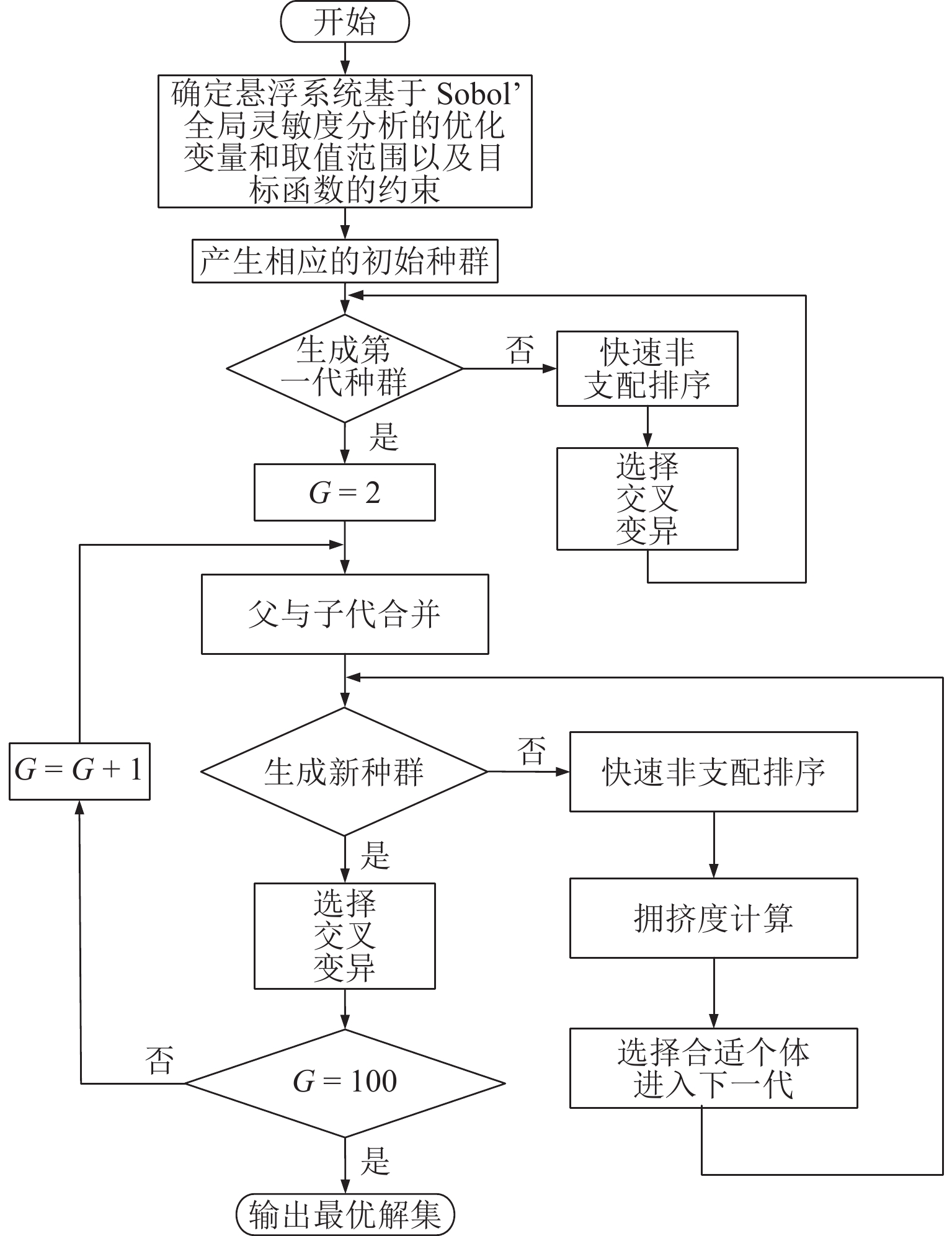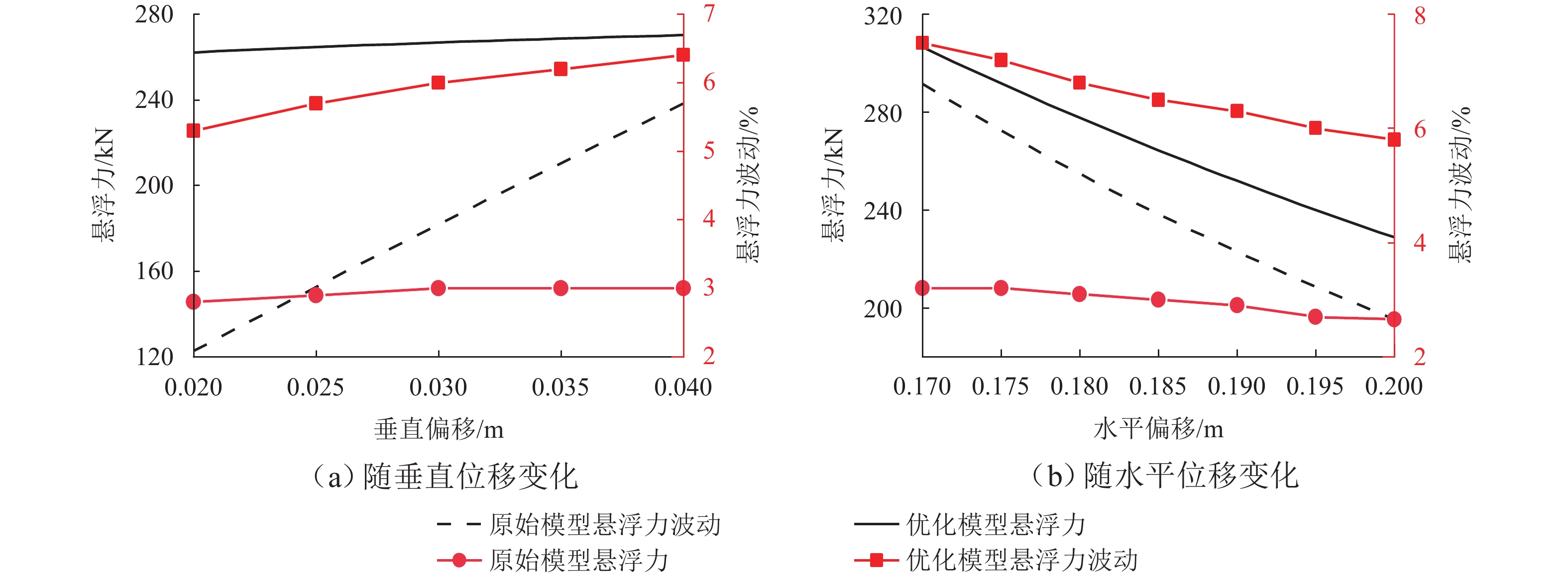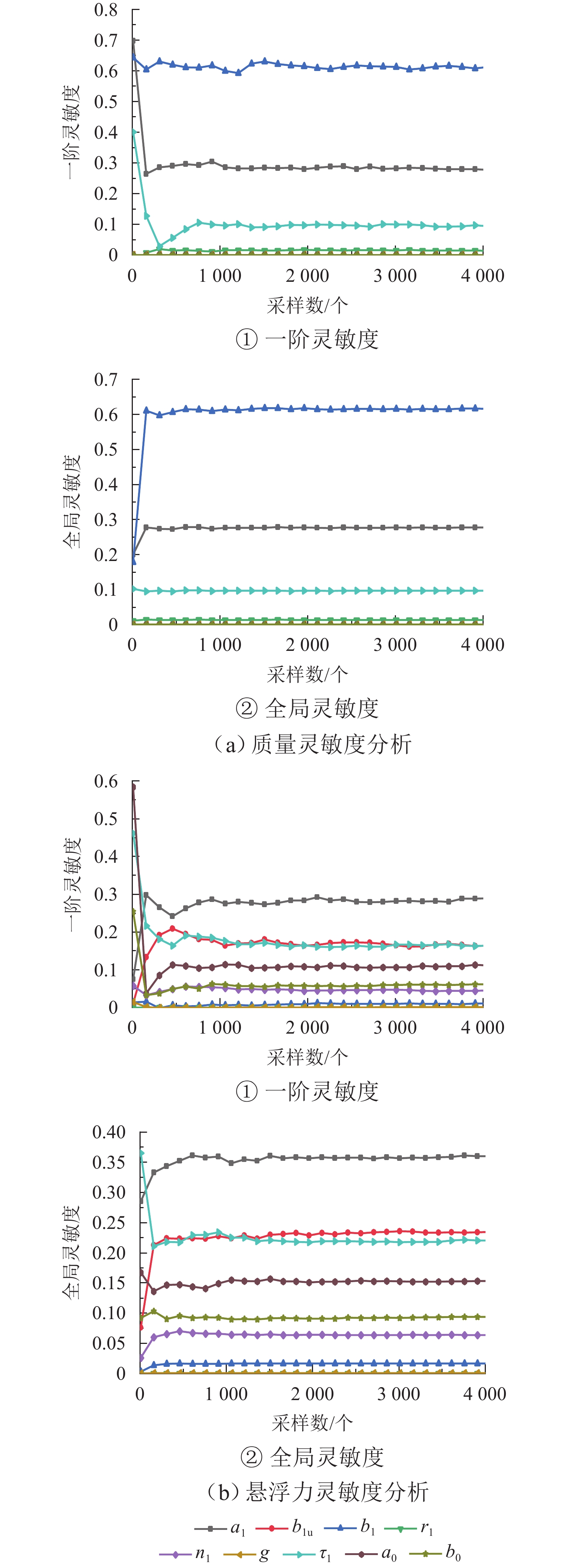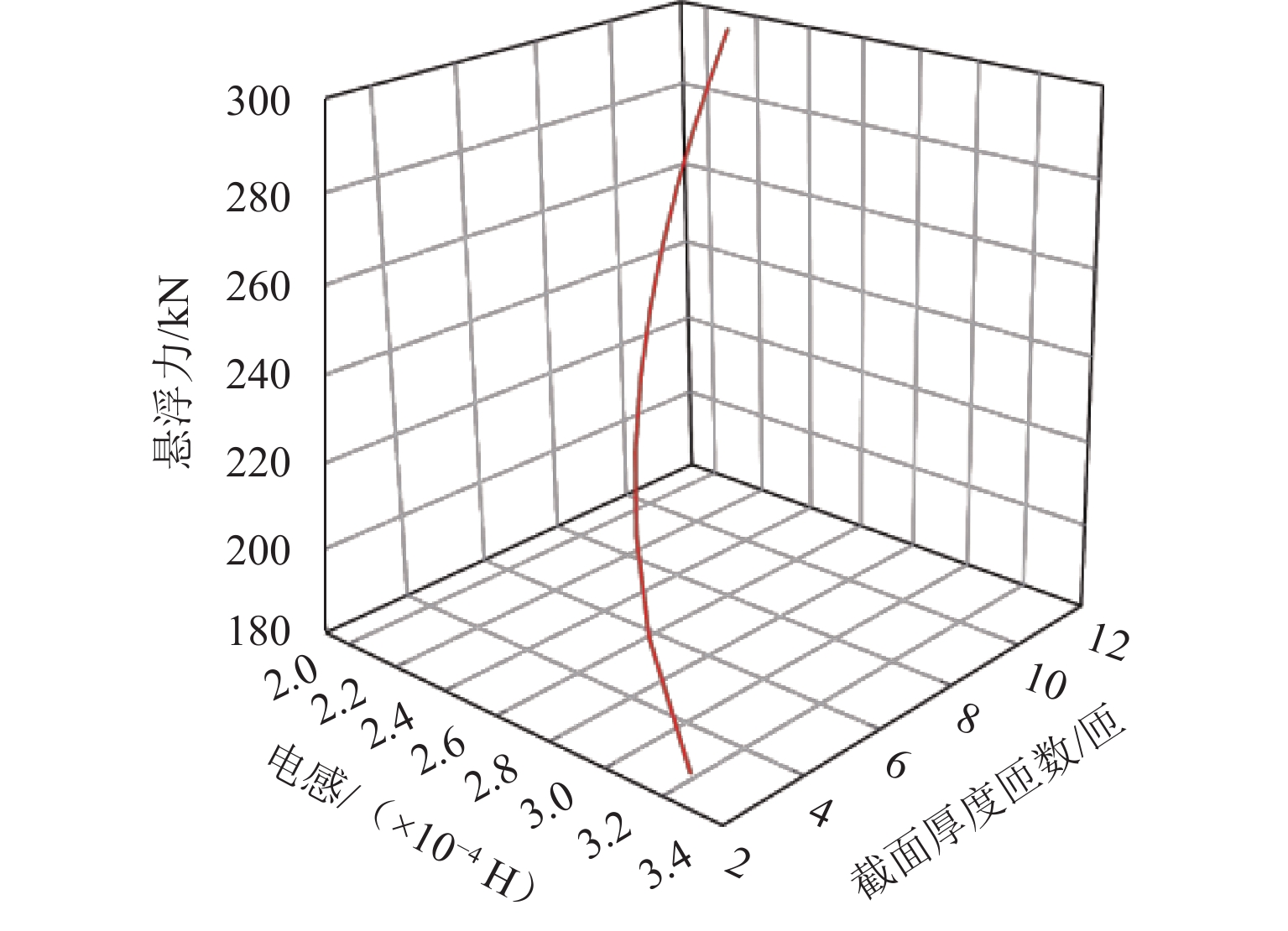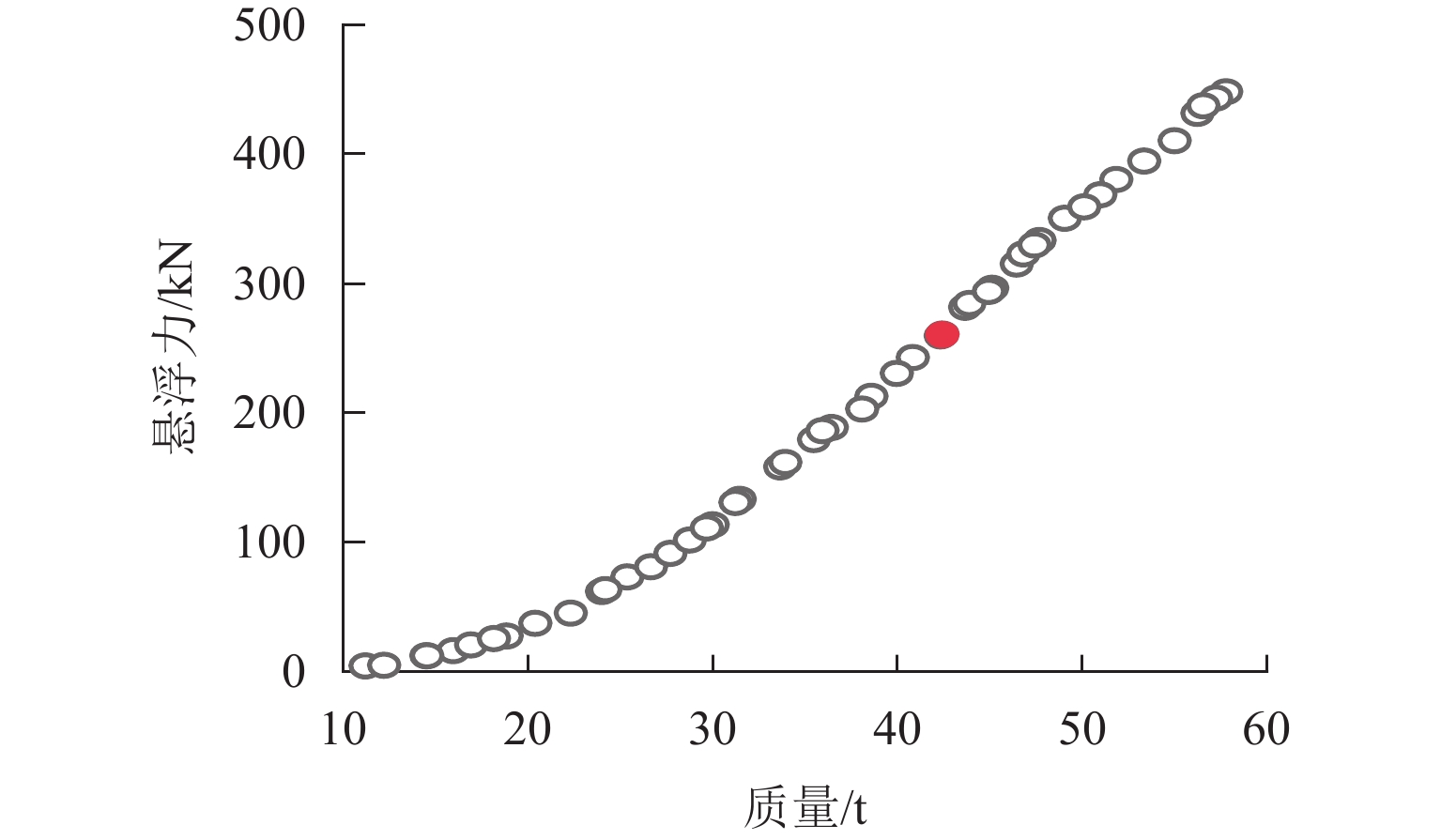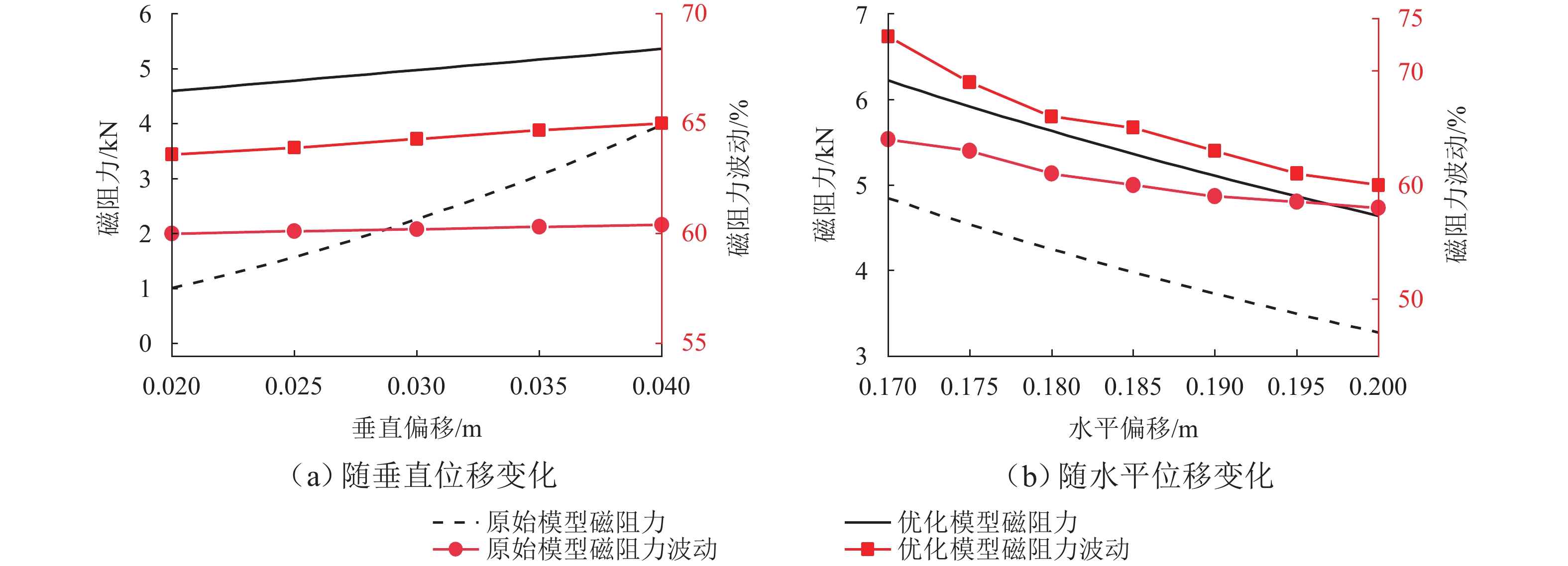Multi-objective Asymmetric Design for Optimizing Superconducting Electrodynamic Suspension System
-
摘要:
为提高超导电动悬浮系统性能,基于全局灵敏度分析和多目标优化算法,提出一种非对称悬浮线圈优化设计方法. 首先,基于空间谐波法建立超导电动悬浮系统的数学模型,计算超导磁体的磁感应强度以及悬浮线圈的电磁力;其次,对此模型进行非对称优化设计,采用Sobol’ 敏感性分析方法,以悬浮力和每公里悬浮线圈质量为目标,计算各设计参数的灵敏度,并基于灵敏度分析结果进行非支配排序遗传算法Ⅱ (NSGA-Ⅱ)优化设计;最后,通过有限元进行仿真分析,验证空间谐波法解析模型,并对优化前后的模型进行比较. 研究结果表明:空间谐波法建立的悬浮系统模型与有限元模型具有一致性;相比优化前,优化后的非对称悬浮系统悬浮力提高8.3%,每公里铺设线圈质量降低12.9%;垂直位移0.02~0.04 m时,悬浮力由262.2 kN增加到270.2 kN,磁阻力由4.5 kN增加到5.4 kN;水平位移0.17~0.20 m时,悬浮力由306.5 kN减小到228.8 kN,磁阻力由6.2 kN减小到4.6 kN;悬浮力、磁阻力的波动分别约为6%、65%. 研究揭示了悬浮力和磁阻力随着位移方向的变化规律,验证了非对称设计在提升悬浮力和轻量化方面的优势,为超导电动悬浮系统的优化设计提供理论参考.
-
关键词:
- 电动悬浮 /
- 灵敏度分析 /
- 非支配排序遗传算法Ⅱ /
- 有限元仿真 /
- 超导磁体
Abstract:In order to improve the performance of superconducting electrodynamic suspension systems, an optimal design method for asymmetric levitation coils was proposed based on global sensitivity analysis and a multi-objective optimization algorithm. First, a mathematical model of the superconducting electrodynamic suspension system was established using the space harmonic method. The magnetic flux intensity of the superconducting magnets and the electromagnetic forces of the levitation coils were then calculated. Next, the model underwent asymmetric optimization. The Sobol’ method was used to calculate the sensitivity of each design parameter, with the levitation force and the mass of the levitation coils per kilometer as the objectives. Based on the sensitivity analysis results, the non-dominated sorting genetic algorithm Ⅱ (NSGA-Ⅱ) was used for optimization. Finally, finite element simulation was carried out to validate the analytical model based on the space harmonic method. The models before and after optimization were compared. The results indicate that the suspension system model established via the space harmonic method was consistent with the finite element model. Compared with the initial system, the optimized asymmetric suspension system shows an 8.3% improvement in levitation force and a 12.9% reduction in the mass of levitation coils per kilometer. When the vertical displacement is 0.02–0.04 m, the levitation force increases from 262.2 kN to 270.2 kN, and the drag force increases from 4.5 kN to 5.4 kN. When the horizontal displacement is 0.17–0.20 m, the levitation force decreases from 306.5 kN to 228.8 kN, and the drag force decreases from 6.2 kN to 4.6 kN. The fluctuations in levitation force and drag force are approximately 6% and 65%, respectively. The variation patterns of levitation and drag forces with respect to displacement directions were revealed, demonstrating the advantages of asymmetric design in enhancing levitation force and achieving lightweight performance. This provides a theoretical reference for the optimal design of superconducting electrodynamic suspension systems.
-
随着世界经济的发展,传统轨道交通运输能力和效率难以满足人们的要求. 更高运行速度和更安全、更舒适乘坐环境的高速磁悬浮列车受到越来越多的关注. 目前,德国的电磁悬浮(EMS)和日本的电动悬浮(EDS)列车已分别达到505 km/h和603 km/h的速度[1-3]. EMS列车通过车载电磁铁与轨道的相互吸引产生悬浮力,实现静态悬浮;其缺点是悬浮气隙小,对于控制精度要求更高,因而车速受到限制. EDS列车通过车载超导磁体与地面线圈的排斥产生悬浮力,具有悬浮气隙大、浮阻比高、自稳定悬浮等优点,成为未来地面高速交通的优势竞争对手之一,具有广阔应用前景[4-6].
近年来,为提升超导电动悬浮系统的性能并降低铺设成本,研究人员提出多种优化方法. Murai等[7]对线圈间距和高度进行优化,并基于模态分析探讨超导磁体(SCM)的振动特性,指出采用下线圈大的非对称线圈结构有助于减小SCM的振动,但该研究未考虑成本因素. 此外,Murai等[8]采用非线性优化设计方法,对推进、悬浮和导向一体化的8字线圈各项特性进行优化,但其综合性能优化仍局限于对各项性能的独立优化,尚未实现多性能指标的协同优化. Chen等[9]研究了37个重叠循环、阶梯和离散循环配置的案例,发现阶梯导轨具备最佳整体性能,但计算成本高且样本量不足. 罗俊等[10]针对对称型悬浮线圈提出基于响应面设计和基于档案的微遗传算法,用于快速优化零磁通线圈设计,降低每公里线圈成本,并提高悬浮性能.
超导电动悬浮系统研究已取得一定进展,特别是悬浮系统的分析与优化方面[11-14]. 本文在此基础上,提出一种新的超导电动悬浮系统优化方法,针对非对称悬浮系统进行设计,以提高列车的悬浮性能,并降低建设成本. 首先,简要介绍超导电动悬浮系统结构;然后,基于空间谐波法建立悬浮系统的数学模型[15-18],并选取9个几何参数进行Sobol’ 灵敏度分析[19-21],选择高灵敏度参数,并基于非支配排序遗传算法Ⅱ(NSGA-Ⅱ)进行多目标优化设计,生成Pareto前沿,最终选择1组优化参数作为优化结果;最后,采用有限元方法验证解析模型,建立优化前后模型对悬浮系统性能进行比较.
1. EDS系统的结构和数学模型
1.1 EDS系统的结构
EDS系统由车体、超导磁体、牵引线圈和8字线圈 [22-24]组成,关键参数如表1所示.
表 1 EDS系统关键参数Table 1. Main parameters of EDS system线圈 符号 描述 幅值 8 字
线圈a1 长度与极距比例 0.778 b1u 上线圈高度占比 0.500 b1b 下线圈高度占比 0.500 b1 上下线圈总高度/m 0.680 zu 上线圈中心高度/m 0.380 zb 下线圈中心高度/m 0.380 c1 线圈截面长度/m 0.060 c2 线圈截面宽度/m 0.040 Ng 线圈匝数/匝 24 Sg 截面线圈每匝面积/mm2 100 τ1 极距/m 0.450 g 上下线圈间隙/m 0.080 r1 线圈圆角半径/m 0.115 超导
线圈a0 长度与极距比例 0.793 b0 高度/m 0.500 d1 线圈截面长度/m 0.040 d2 线圈截面宽度/m 0.070 Ns 线圈匝数/匝 1400 超导
线圈Is 额定电流/A 500 τ0 极距/m 1.350 y1 8 字线圈与超导线圈水平距离/m 0.185 Δz 8 字线圈与超导线圈中心垂直位移/m 0 EDS系统截面如图1所示. 超导磁体安装在车体两侧,左右两侧磁场方向相反. 牵引线圈和超导磁体构成长定子直线同步电机,为列车提供牵引力, 8字线圈与超导磁体形成悬浮和导向系统,为列车提供悬浮力和导向力.
图2为EDS系统单侧结构[25-26],由于EDS系统导轨两侧对称,建立基于EDS单侧结构的数学模型. 本文选择最小的单元,即1对超导磁体对应6个8字线圈.
1.2 EDS系统的数学模型
基于空间谐波法建立超导电动悬浮系统的数学模型,其基本思想是用傅里叶级数展开来描述超导磁体在空间中的磁场分布. 计算出超导磁体的磁感应强度为
B(x,y,z)=8μ0NsIsτ0τz∞∑m=1∞∑n=1λmnf0(m,n) ×cos(kxmx)cos(kznz)e−λmny, (1) 式中:kxm为x方向第m次谐波频率;kzn为z方向第n次谐波频率;λmn=√k2xm+k2zn;μ0为空气的磁导率;τz为z方向超导磁体极距,τz=kb0, k=3~5;f0(m,n)为与超导线圈尺寸排列相关的函数,如式(2)所示.
{f0(m,n)=sin(kxma0τ02)kxmsin(kznb02)kzn,kxm=mπτ0,kzn=nπτz,m,n=1,3,5,⋯. (2) 得到磁感应强度的空间分布后,计算第l个8字线圈磁通,其中心坐标为(xl, yl, zl),l=1,2,⋯.单个8字线圈中,上下线圈的净磁通相互抵消. 因此,通过8字线圈的总净磁通为
Φl=∞∑m=1P(m)cos(kxmxl), (3) 式中:P(m)为Φl余弦形式傅里叶级数系数,如式(4)所示,反映超导线圈与8字线圈之间耦合松紧程度的函数;xl为第l个8字线圈的x方向坐标,xl=lτ1+vt,v为速度,t为时间.
{P(m)=4μ0NsIsτ0τz∞∑n=1λmnf0(m,n)[flu(m,n)cos[kzn×(zu+Δz)]−flb(m,n)cos[kzn(zb−Δz)]]e−λmnyl,flu(m,n)=sin(kxma1τ12)sin(kznb1ub12)/(kxmkzn),flb(m,n)=sin(kxma1τ12)sin(kznb1bb12)/(kxmkzn), (4) 式中:flu(m,n)、flb(m,n)分别为与8字线圈上、下线圈尺寸排列相关的函数.
8字线圈极距与超导磁体极距之间存在τ0=3τ1的关系,因此式(3)可以写为
Φl=∞∑m=1P(m)cos(mωt+mπl3), (5) 式中:ω=πvτ0.
第l个8字线圈对应的电压方程为
Ril+Ldildt=−NgdΦldt, (6) 式中:R、L、il分别为第l个8字线圈的电阻、电感和产生的感应电流.
第l个8字线圈的感应电压el和感应电流il为
{el=Ngω∞∑m=1mP(m)sin(mωt+mπl3),il=∞∑m=1Ngmω|R+jmωL|P(m)sin(mωt+mπl3−δ), (7) 式中:δ=arctgωLR.
通过能量法,计算第l个8字线圈对应的三维电磁力为
{fx=∂Wl∂x=∂(ilΦl)∂x,fy=∂Wl∂y=∂(ilΦl)∂y,fz=∂Wl∂z=∂(ilΦl)∂z, (8) 式中:Wl为第l个8字线圈的能量,fx、fy、fz分别为磁阻力、导向力和悬浮力.
2. 悬浮系统灵敏度分析
2.1 基于Sobol’ 的灵敏度分析
Sobol’ 灵敏度分析方法通过将函数模型分解为单个参数以及参数之间的组合,计算输入单一参数或输入参数集的方差对总方差的影响,从而分析参数变化对模型性能的影响.
假设悬浮系统模型为Y=f(X),其中,X={X1,X2,⋯,Xi,⋯,XN},Xi为第i个参数,服从[0,1]的均匀分布. 如果模型f(X)是平方可积的,则模型可分解为
f(X)=fc+∑1⩽i⩽Nfi(Xi)+∑1⩽i⩽j⩽Nfi,j(Xi,Xj)+⋯+f1,2,⋯,N(X1,X2,⋯,XN), (9) 式中:fc为常量,其值等于f(X)的期望值;fi(Xi)为一阶子项,仅依赖单个输入参数Xi;fi,j(Xi, Xj)为二阶子项,依赖输入参数Xi和Xj的相互作用;f1,2,⋯,N为N阶子项,与参数X1、X2、⋯、XN的相互作用相关.
各子项满足条件
∫10f1,2,⋯,s(X1,X2,⋯,Xs)dXk=0, (10) 式中:1⩽k⩽s,s=1,2,⋯,N.
由式(10)和f(X)平方可积性,总方差D和各个变量的偏方差D1,2,⋯,s可分别表示为
{D=∫10f2(X)dX−f2c,D1,2,⋯,s=∫10∫10⋯∫10f21,2,⋯,s(X1,X2,⋯,Xs)dX1dX2⋯dXs. (11) 总方差与各变量的偏方差之和相等,即
D=∑1⩽i⩽NDi+∑1⩽i⩽j⩽NDi,j+⋯+D1,2,⋯,N, (12) 式中:Di为一阶偏方差,Di,j为二阶偏方差,D1,2,⋯,N为N阶偏方差.
对于输入参数变量Xi,一阶灵敏度系数Si为
Si=DiD. (13) 一阶灵敏度系数主要考虑单个变量对系统的影响,未考虑变量与其他变量的交互作用. 为解决该问题,定义变量Xi的总灵敏度系数Si,T如式(14)所示. 总灵敏度系数越高,表明该变量对系统的影响越明显.
Si,T=D−D∼iD, (14) 式中:D∼i为不包含Xi参数的偏方差之和,D−D∼i为Xi与其他参数相互作用偏方差之和.
2.2 设计变量和优化目标
图3为超导线圈和8字线圈的几何关系与参数示意. 设计参数及变量范围如表2所示,n1、n2分别为长度、宽度对应的线圈匝数,且n2=Ng/n1.
表 2 设计参数及其变量范围Table 2. Design parameters and their variable ranges参数 变量范围 参数 变量范围 a1 [0.500,0.900] g/m [0.060,0.100] b1u [0.200,0.400] τ1/m [0.400,0.600] b1/m [0.200,0.800] a0 [0.700,0.800] r1/m [0.100,0.200] b0/m [0.200,0.600] n1/匝数 [2,12] Sobol’全局灵敏度分析方法的计算结果与采样规模有显著关系,样本规模较小会影响结果的真实性. 不同采样数量下,各参数对质量和悬浮力的一阶灵敏度与全局灵敏度的表现如图4所示. 当样本规模达到
3000 个左右时,一阶灵敏度和全局灵敏度趋于稳定,不再随采样规模的增加而显著变化. 因此,本文选择样本规模为4000 个,分析悬浮系统设计参数对质量和悬浮力的灵敏度.2.3 悬浮系统参数对每公里八字线圈质量的灵敏度分析
由图4(a)可知,在参数取值范围内,a1、b1和τ1对质量的影响较为显著,其余参数对质量的影响十分微弱. b1和τ1的全局灵敏度均大于一阶灵敏度,表明其与其他参数间的相互作用对每公里8字线圈质量的影响显著;参数a1的一阶灵敏度与全局灵敏度相差不大. 在参数设计中应选择影响较大的a1、τ1和b1.
8字线圈的长和高决定了其总长度,对质量影响较大,由于计算的是每公里8字线圈的质量,极距决定了每公里8字线圈的个数,进而影响了总质量. 超导线圈参数不直接影响8字线圈的质量,与质量无关.
2.4 悬浮系统参数对悬浮力的灵敏度分析
由图4(b)可知,在参数取值范围内,a1、b1u、n1、τ1、a0和b0对悬浮力的影响较大,且其全局灵敏度均大于一阶灵敏度,表明其与其他参数间的相互作用对悬浮力影响明显; b1对悬浮力的影响相对较小; g和r1对悬浮力的影响十分微弱. 因此,在设计参数时,应选择影响较大的a1、b1u、n1、τ1、a0和b0.
8字线圈的长和上线圈高与超导线圈的长和高对悬浮力有较大影响,两者的耦合面积与悬浮力密切相关. 悬浮力与电感以及线圈截面宽度的关系如图5所示,线圈截面宽度越大,8字线圈越厚,电感越小,提供悬浮力越大.
3. 基于灵敏度分析的NSGA-Ⅱ优化设计
3.1 悬浮系统多目标约束优化模型
为降低非对称悬浮系统优化的设计空间维度,提高求解效率,基于悬浮系统的参数灵敏度数据,选择如下参数作为优化设计变量:a1、b1u、n1、τ1、a0和b0. 参数的取值范围及初始值见表2,其他设计参数的取值参照表1.
在悬浮系统优化设计过程中,悬浮线圈的质量和悬浮力是2个重要的设计指标,优化目标为最小化悬浮线圈质量的同时最大化悬浮力. 令 M 表示每公里8字线圈质量,可表示为
M=2(b1+a1τ1)SgNg×2700×2×1000/τ1. (15) 优化要求悬浮力Fz大于初始值,而质量小于初始值,悬浮线圈匝数设定为24匝. 优化后的边界条件如式(16)所示.
{Fz⩾240kN,M⩽59.3t,n1n2=24. (16) 结合悬浮系统多目标优化模型,采用NSGA-Ⅱ算法进行求解. 首先,基于Sobol’全局灵敏度分析确定优化变量及其取值范围,并设置目标函数的约束;然后,随机产生规模为50的初始种群,经过非支配排序,通过遗传算法的选择、交叉、变异3个基本操作生成第一代子种群;从第二代开始,将父代种群与子代种群合并,进行快速非支配排序,同时对每个非支配层中的个体进行拥挤计算,根据非支配关系和个体拥挤度选择合适的个体组成新的父代种群;最后,通过遗传算法的基本操作生成新的子代种群,依次类推,直到达到最大迭代次数100次. 该算法流程见图6. 图中,G为总进化代数.
3.2 悬浮系统优化数据分析
悬浮系统优化模型的基本参数设置如下:种群规模为50,迭代次数G为100次. 结合悬浮系统模型,使用NSGA-Ⅱ算法求得的Pareto最优前沿如图7所示. 选择Pareto最优前沿的样本作为优化结果. 优化后,M=42.4 t,Fz=260 kN,每公里铺设线圈质量降低12.9%,悬浮力提高8.3%. 优化方案参数见表3.
表 3 优化方案参数Table 3. Optimized design parameters参数 目标值 参数 目标值 a1 0.580 τ1/m 0.600 b1u 0.350 a0 0.800 n1/匝 12 b0/m 0.500 4. 性能比较
基于空间谐波法和有限元方法,建立悬浮系统模型,并对比2种分析方法下的感应电流和磁阻力. 图8(a)为感应电流计算结果. 在有限元模型中,由于线圈初始电流为0,感应电流需要经过一段时间才能达到稳定状态. 空间谐波法的计算结果与有限元仿真结果较为一致,单个8字线圈内部的环流峰值约为2.4 kA. 图8(b)为磁阻力计算结果,2种方法的磁阻力波形趋势相似,随着速度增大,磁阻力先增加后减小. 当速度达到80 km/h时,磁阻力达到峰值,约为13.7 kN,随后速度继续增加时,磁阻力减小,当速度600 km/h时,磁阻力约为4.0 kN.
通过对比优化前后模型的悬浮力和磁阻力以及它们随垂直和水平位移的波动特性,以比较悬浮系统的优化效果,如图9、10所示.
在速度600 km/h、水平位移0.185 m、垂直位移在0.02~0.04 m的条件下,分析EDS系统性能. 如图9(a)所示,悬浮力随垂直位移的增大而增大;原系统悬浮力从122.8 kN增加到240.0 kN,而优化后的系统从262.2 kN增加到270.2 kN;原系统的悬浮力波动约为3.0%,而优化后的悬浮力波动为6.0%左右. 如图10(a)所示,原系统的磁阻力由1.0 kN增加至4.0 kN,波动相对稳定在60.0%左右;优化后的磁阻力由4.5 kN增加至5.4 kN,波动约为64.0%.
在速度600 km/h、垂直位移0.04 m、水平位移0.170~0.200 m的条件下,分析EDS系统性能. 如图9(b)所示,随着水平位移的增大,悬浮力减小;原系统悬浮力从291.5 kN减小至195.3 kN,波动约为2.8%,优化后系统的悬浮力从306.5 kN减小至228.8 kN,波动为6.5%左右;相同条件下,优化后的系统悬浮力及其波动均高于原系统. 如图10(b)所示,随着水平位移的增加,原系统的磁阻力由4.8 kN降低至3.3 kN,波动从64.0%降低至58.0%;优化后,系统磁阻力由6.2 kN降低至4.6 kN,波动从73.0%降低至60.0%. 随着水平位移增加,电磁间隙增加,磁感应强度变弱,悬浮力和磁阻力及其波动也随之减小.
5. 结 论
本文对超导电动悬浮系统进行了分析,同时利用Sobol’ 敏感性分析及NSGA-Ⅱ进行非对称优化设计. 主要结论如下:
1) 基于空间谐波法建立的超导电动悬浮系统模型,与有限元模型的趋势一致,验证了空间谐波法的有效性.
2) 采用Sobol’全局灵敏度分析,选择敏感性较强的变量,为NSGA-Ⅱ设计提供优化参数,从而提高计算效率.
3) 优化后系统每公里铺设线圈的质量降低12.9%,悬浮力提高8.3%, 但悬浮力及其波动、磁阻力及其波动均有所增加.
4) 在所研究的位移范围内,悬浮系统的悬浮力和磁阻力及其波动随垂直位移的增加而增加,而随水平位移的增加逐渐减小.
通过基于空间谐波法和Sobol’全局灵敏度分析提出的非对称系统多目标优化设计,本文能够缩短设计周期,为在对运行平稳性和舒适性要求相对较低的高速电磁推进系统提供理论依据.
-
表 1 EDS系统关键参数
Table 1. Main parameters of EDS system
线圈 符号 描述 幅值 8 字
线圈a1 长度与极距比例 0.778 b1u 上线圈高度占比 0.500 b1b 下线圈高度占比 0.500 b1 上下线圈总高度/m 0.680 zu 上线圈中心高度/m 0.380 zb 下线圈中心高度/m 0.380 c1 线圈截面长度/m 0.060 c2 线圈截面宽度/m 0.040 Ng 线圈匝数/匝 24 Sg 截面线圈每匝面积/mm2 100 τ1 极距/m 0.450 g 上下线圈间隙/m 0.080 r1 线圈圆角半径/m 0.115 超导
线圈a0 长度与极距比例 0.793 b0 高度/m 0.500 d1 线圈截面长度/m 0.040 d2 线圈截面宽度/m 0.070 Ns 线圈匝数/匝 1400 超导
线圈Is 额定电流/A 500 τ0 极距/m 1.350 y1 8 字线圈与超导线圈水平距离/m 0.185 Δz 8 字线圈与超导线圈中心垂直位移/m 0 表 2 设计参数及其变量范围
Table 2. Design parameters and their variable ranges
参数 变量范围 参数 变量范围 a1 [0.500,0.900] g/m [0.060,0.100] b1u [0.200,0.400] τ1/m [0.400,0.600] b1/m [0.200,0.800] a0 [0.700,0.800] r1/m [0.100,0.200] b0/m [0.200,0.600] n1/匝数 [2,12] 表 3 优化方案参数
Table 3. Optimized design parameters
参数 目标值 参数 目标值 a1 0.580 τ1/m 0.600 b1u 0.350 a0 0.800 n1/匝 12 b0/m 0.500 -
[1] NASIRI-ZARANDI R, HEKMATI A. A review of suspension and traction technologies in maglev trains[C]//2019 International Power System Conference (PSC). Tehran: IEEE, 2019: 129-135. [2] PHAENKONGNGAM T, CHINNAWONG K, PATUMASUIT N, et al. Reviewing propulsion & levitation system for magnetic levitation train[C]//2021 9th International Electrical Engineering Congress (iEECON). Pattaya: IEEE, 2021: 185-188. [3] 熊嘉阳,邓自刚. 高速磁悬浮轨道交通研究进展[J]. 交通运输工程学报,2021,21(1): 177-198.XIONG Jiayang, DENG Zigang. Research progress of high-speed maglev rail transit[J]. Journal of Traffic and Transportation Engineering, 2021, 21(1): 177-198. [4] 刘士苋,王磊,王路忠,等. 电动悬浮列车及车载超导磁体研究综述[J]. 西南交通大学学报,2023,58(4): 734-753. doi: 10.3969/j.issn.0258-2724.20220621LIU Shixian, WANG Lei, WANG Luzhong, et al. Review on electrodynamic suspension trains and on-board superconducting magnets[J]. Journal of Southwest Jiaotong University, 2023, 58(4): 734-753. doi: 10.3969/j.issn.0258-2724.20220621 [5] 张榕欣,蔡小培,汤雪扬,等. 超导电动磁浮道岔线形设计与侧向过岔速度优化[J]. 西南交通大学学报,2025,60(4):893-903.ZHANG Rongxin, CAI Xiaopei, TANG Xueyang, et al. Alignment design of superconducting electrodynamic suspension turnouts and optimization of lateral crossing speed[J]. Journal of Southwest Jiaotong University, 2025, 60(4):893-903. [6] 赵春发,李煜寒,彭也也,等. 超导电动悬浮列车明线气动特性及其对悬浮状态的影响[J]. 西南交通大学学报,2025,60(4):793-802.ZHAO Chunfa, LI Yuhan, PENG Yeye, et al. Aerodynamic characteristics of open wire of superconducting maglev train and its influence on levitation state[J]. Journal of Southwest Jiaotong University, 2025, 60(4):793-802. [7] MURAI T, IWAMATSU M, YOSHIOKA H. Optimized design of 8-figure null-flux coils in EDS maglev[J]. IEEJ Transactions on Industry Applications, 2003, 123(1): 9-14. doi: 10.1541/ieejias.123.9 [8] MURAI T, FUJIWARA S. Design of coil specifications in EDS maglev using optimization program[J]. IEEJ Transactions on Industry Applications, 1997, 117(7): 905-911. doi: 10.1541/ieejias.117.905 [9] CHEN Y J, FENG J. Optimization of guideway coil dimensions for a magnetic levitation system[J]. IEEE Transactions on Magnetics, 1997, 33(5): 4335-4344. doi: 10.1109/20.620443 [10] CUI L B, LUO J, SU Z H, et al. Fast optimization of null-flux coils for superconducting electrodynamic suspension train with RSM and AMGA[J]. IEEE Transactions on Applied Superconductivity, 2022, 32(5): 3602308.1-3602308.8. [11] 王志涛,蔡尧,龚天勇,等. 基于场–路–运动耦合模型的超导电动悬浮列车特性研究[J]. 中国电机工程学报,2019,39(4): 1162-1171.WANG Zhitao, CAI Yao, GONG Tianyong, et al. Characteristic studies of the superconducting electrodynamic suspension train with a field-circuit-motion coupled model[J]. Proceedings of the CSEE, 2019, 39(4): 1162-1171. [12] GONG X X, LU Q F, LI Y X. Multi-objective optimization for the levitation system of the electrodynamic suspension train with HTS magnets[C]//2021 13th International Symposium on Linear Drives for Industry Applications (LDIA). Wuhan: IEEE, 2021: 1-6. [13] HUANG H, DENG Z G, LI H T, et al. Numerical simulation of dynamic electromagnetic characteristics of superconducting electrodynamic suspension (EDS) train[J]. IEEE Transactions on Applied Superconductivity, 2021, 31(5): 3601105.1-3601105.5. [14] NING X F, ZHAO C F, YU Q S, et al. Suspension and guidance performance of a new superconducting EDS system using the 8-shaped ground coils with nonequal turns[J]. IEEE Transactions on Applied Superconductivity, 2024, 34(4): 3601511.1-3601511.11. [15] 王小农,黄靖宇. 超导电动磁浮列车悬浮和导向特性[J]. 同济大学学报(自然科学版),2022,50(10): 1482-1489.WANG Xiaonong, HUANG Jingyu. Levitation and guidance characteristics of superconducting electrodynamic maglev train[J]. Journal of Tongji University (Natural Science), 2022, 50(10): 1482-1489. [16] YONEZU T, WATANABE K, SUZUKI E, et al. Study on electromagnetic force characteristics acting on levitation/guidance coils of a superconducting maglev vehicle system[J]. IEEE Transactions on Magnetics, 2017, 53(11): 8300605.1-8300605.5. [17] NONAKA S, HIROSAKI T, KAWAKAMI E. Analysis of characteristics of repulsive magnetic levitated train using a space harmonic technique[J]. Electrical Engineering in Japan, 1980, 100(5): 80-88. doi: 10.1002/eej.4391000512 [18] RIBANI P L, URBANO N. Study on figure-eight-shaped coil electrodynamic suspension magnetic levitation systems without cross-connection[J]. IEEE Transactions on Magnetics, 2000, 36(1): 358-365. doi: 10.1109/20.822547 [19] Sobol I M. Global sensitivity indices for nonlinear mathematical models and their Monte Carlo estimates[J]. Mathematics and Computers in Simulation, 2001, 55(1/2/3): 271-280. [20] 宋健,佘湖清,李超,等. 基于Sobol’ 灵敏度分析的火箭弹自力弹射多目标约束优化[J]. 推进技术,2022,43(12): 40-48.SONG Jian, SHE Huqing, LI Chao, et al. Multi-object constraint optimization of rocket self-ejection based on Sobol’ sensitivity analysis[J]. Journal of Propulsion Technology, 2022, 43(12): 40-48. [21] 倪菲,范琳,徐俊起,等. 基于Sobol’ 法的高速磁浮列车单点悬浮系统全局灵敏度分析[J]. 西南交通大学学报,2025,60(4): 812-822.NI Fei, FAN Lin, XU Junqi, et al. Global sensitivity analysis of single-point levitation system for high-speed maglev train based on Sobol’ method[J]. Journal of Southwest Jiaotong University, 2025, 60(4): 812-822. [22] 谭富星,李凯,于淼,等. 超导电动悬浮试验线悬浮系统设计及验证[J]. 机车电传动,2024(3): 13-18.TAN Fuxing, LI Kai, YU Miao, et al. Design and verification of levitation system for superconducting electrodynamic suspension test line[J]. Electric Drive for Locomotives, 2024(3): 13-18. [23] OHASHI S, UEDA N. Dependence of the quenched SC coil position on the transient motion of the superconducting magnetically levitated bogie[J]. IEEE Transactions on Applied Superconductivity, 2016, 26(4): 3600604.1-3600604.4. [24] LEE H W, KIM K C, LEE J. Review of maglev train technologies[J]. IEEE Transactions on Magnetics, 2006, 42(7): 1917-1925. doi: 10.1109/TMAG.2006.875842 [25] 邓自刚,刘宗鑫,李海涛,等. 磁悬浮列车发展现状与展望[J]. 西南交通大学学报,2022,57(3): 455-474,530. doi: 10.3969/j.issn.0258-2724.20220001DENG Zigang, LIU Zongxin, LI Haitao, et al. Development status and prospect of maglev train[J]. Journal of Southwest Jiaotong University, 2022, 57(3): 455-474,530. doi: 10.3969/j.issn.0258-2724.20220001 [26] 徐杰. 超导磁悬浮列车用直线发电机的设计与特性解析分析[D]. 北京:北京交通大学,2020. -





 下载:
下载:











 下载:
下载:




